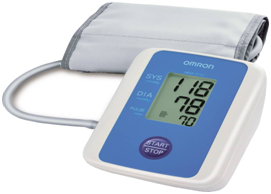-
The word sphygmomanometer formed from to words sphygmo+manometer. The roots involved are as follows:Greek"pulse", plus the scientific term manometer, i.e. “pressure meter”, itself coined from manos “thin, sparse”, and metron “measure”.
-
Most sphygmomanometers were mechanical gauges with dial faces during the first half of the 20th century. Since the advent of electronic medical devices, names such as “meter” and “monitor” can also apply, as devices can automatically monitor blood pressure on an ongoing basis.
-
A sphygmomanometer is a device that measures blood pressure. It composes of an inflatable rubber cuff, which is wrapped around the arm. A measuring device indicates the cuff’s pressure. A bulb inflates the cuff and a valve releases pressure. A stethoscope is used to listen to arterial blood flow sounds.
-
As the heart beats, blood forced through the arteries cause a rise in pressure, called systolic pressure, followed by a decrease in pressure as the heart’s ventricles prepare for another beat. This low pressure is called the diastolic pressure.
The sphygmomanometer cuff is inflated to well above expected systolic pressure. As the valve is opened, cuff pressure (slowly) decreases. When the cuff’s pressure equals the arterial systolic pressure, blood begins to flow past the cuff, creating blood flow turbulence and audible sounds. Using a stethoscope, these sounds are heard and the cuff’s pressure is recorded. The blood flow sounds will continue until the cuff’s pressure falls below the arterial diastolic pressure. The pressure when the blood flow sounds stop indicates the diastolic pressure.
Systolic and diastolic pressures are commonly stated as systolic ‘over’ diastolic. For example, 120 over 80. Blood flow sounds are called Korotkoff sounds.
Description of instrument:
Your heart is an continuous pump. It works life long, and it safely pumps blood – one of the trickiest liquids around. In the same way, your blood vessels are pipes. They take the output from the pump and distribute it throughout the body. A blood pressure gauge is simply a way to measure the performance of the pump and the pipes.
There are two numbers in a blood pressure reading: systolic and diastolic. For example, a typical reading might be 120/80. When the doctor puts the cuff around your arm and pumps it up, what he/she is doing is cutting off the blood flow with the pressure exerted by the cuff. As the pressure in the cuff is released, blood starts flowing again and the doctor can hear the flow in the stethoscope. The number at which blood starts flowing (120) is the measure of the maximum output pressure of the heart (systolic reading). The doctor continues releasing the pressure on the cuff and listens until there is no sound. That number (80) indicates the pressure in the system when the heart is relaxed (diastolic reading).
If the numbers are too high, it means that the heart is having to work too hard because of restrictions in the pipes. Certain hormones, like adrenaline (which is released when you are under stress) cause certain blood vessels to constrict, and this raises your blood pressure – if you are under constant stress, your blood pressure goes up, and it means that your heart has to work too hard. Other things that can increase the blood pressure include deposits in the pipes and a loss of elasticity as the blood vessels age.
High blood pressure can cause the heart to fail (from working too hard), or it can cause kidney failure (from too much pressure).
Sphygomanometer device


Omron HEM-7112 BP
Specification:
Accuracy: Pressure mm Hg Pule 5 percent of reading
-
Upper Arm BP Monitor
-
Pulse Rate Indicator
-
Maximum Pressure Measurement Range: 299 mm Hg
-
Maximum Pulse Measurement Range: 180 Beats/min
Measurement method :Oscillometric method
Dangers due to high blood pressure:
In these situations, high blood pressure can cause:
• Memory loss, personality changes, trouble concentrating, irritability or progressive loss of consciousness
• Stroke
• Severe damage to your body’s main artery (aortic dissection)
• Chest pain
• Heart attack
• Sudden impaired pumping of the heart, leading to fluid backup in the lungs resulting in shortness of breath (pulmonary edema)
• Sudden loss of kidney function
• Complications in pregnant women (preeclampsia or eclampsia)
Dangers due to low blood pressure:
For some people, low blood pressure signals an underlying problem, especially when it drops suddenly or is accompanied by signs and symptoms such as:
• Dizziness or light headedness
• Fainting(syncope)
• Blurred vision
• Nausea
• Fatigue
• Lack of concentration
